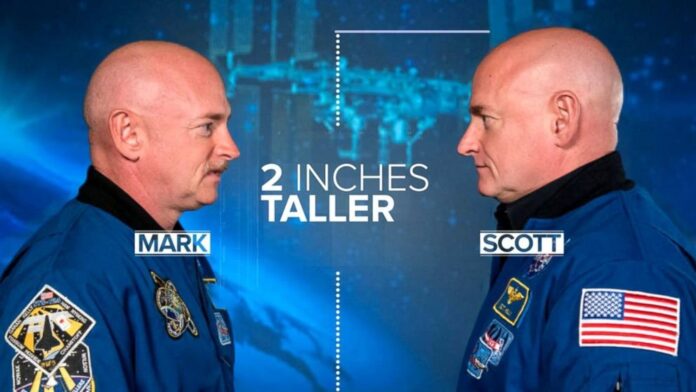When Scott Kelly spent 340 days on the International Space Station (ISS) upon return to Earth he participated in a twin study with his brother astronaut Mark to see how prolonged microgravity made changes to the former’s physiology.
Scott recorded a decrease in body mass, changes to over 1,000 genes, swelling in major blood vessels, changes in eye shape, metabolism shifts, inflammation, alterations in his microbiome, and the lengthening of the telomeres at the end of each of his chromosomes. Besides that, he came back to Earth 5 centimeters (two inches) taller than his brother. The changes to genes included those that regulate DNA damage and the immune system response, the latter exhibiting a high state of alert. The lengthening of the telomeres which cap the ends of chromosomes changed temporarily because upon Scott’s return to Earth they returned to the same average length with some even shorter within two days. Shorter telomeres indicate a risk factor related to age-associated diseases.
But one issue not immediately described was changes that occurred in Scott’s heart. On March 29, 2021, the journal Circulation published a study that told an interesting story. It compared changes to Scott’s heart after 340 days in space with the heart of a French endurance swimmer, Benoit Lecomte, who swam 2,821 kilometers (1.753 miles) over a 159-day period.
A swimmer here on Earth experiences the closest thing to the microgravity environment in space. NASA has a neutral-buoyancy facility, a large and deep swimming pool where astronauts train to become proficient at working in weightlessness.
Comparing Monsieur Lecomte’s heart after his swim of 159 days across the Atlantic Ocean from June to November of 2018 with Scott’s heart showed rates of decline in heart mass and its ability to pump. But weightlessness in space compared to long-duration swimming revealed a greater loss of cardiac mass in the former than the latter. Lecomte’s training involved high-intensity swimming for 1 to 3 hours daily. When crossing the Atlantic he averaged 5.8 hours in the water daily. Whereas Scott exercised using a stationary bicycle, treadmill, and muscle resistance equipment, 6 days a week. Despite that, Scott’s heart mass shrank by more than 25%.
What are the implications of a loss of heart mass for astronauts on long-duration Deep Space flights such as future plans to go to Mars? Without gravity, hearts don’t have to work as hard. That’s one of many physiological changes to the human body that NASA has determined require astronauts to exercise while in microgravity. On the ISS, astronauts are expected to exercise for several hours daily to counter losses in muscle and bone mass. The heart is no exception.
One solution for long-duration space flight is to create artificial gravity. On space science fiction television shows and movies with the exception of Stanley Kubrick’s 2001: A Space Odyssey, people in space seem to be able to walk around in spaceships just as if they were promenading here on Earth. But short of magnetizing surfaces and wearing magnetic boots, that is impossible.
What is possible is using centrifugal force to create the same effect as gravity. Einstein was the first to show that gravity and acceleration are identical. Using acceleration therefore can create the same kind of weight experience we have here on Earth. But a spaceship cannot always be accelerating with engines going full blast. A chemical rocket engine eventually runs out of fuel. But centrifugal acceleration produced by spinning the entire spaceship or a portion of it at just the right rate could produce the equivalent of Earth gravity which would mean the human body would not have to adapt to long-term exposure to microgravity. For our heart, used to circulating blood through our bodies while fighting the force of gravity, it would be ideal.
The question for engineers designing a spaceship going to Mars and back is how do you integrate gravity into the design. And how much gravity effect is needed for the optimal health of astronauts undergoing such long journeys? Today, there is no component of the ISS that rotates to create the centrifugal force equivalent to Earth-level gravity which we call 1 G. And we still don’t know if we need to create a 1 G environment on board spaceships doing Deep Space missions. Maybe, 0.5 G-environments may be enough to stop the physiological deterioration of our bodies. And we don’t know if we have to create the centrifugal force in our spaceship continuously, or just for a few hours per day to gain the benefits to our physiological health.
Or could we create an exercise environment in which individual astronauts could sit in a centrifuge of some type that would expose them to a 1 G environment for a specified period of time each day?
A recording from December 2020, has been released recently as a NASA podcast that discusses the issue of creating artificial gravity for human spaceflight. It is a conversation between Bill Paloski, former director of the Human Research Program at NASA’s Johnson Space Center, and the host, Gary Jordan. It is well worth listening to or reading the transcript if you are interested in learning more about how NASA has wrestled with the issue of keeping astronauts healthy in space and where and how artificial gravity can be engineered into future spaceship and space station designs.
















